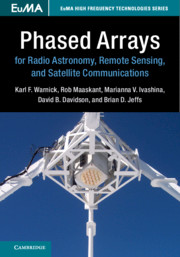Book contents
- Frontmatter
- Contents
- Preface
- Acknowledgements
- Notation and Units
- 1 Phased Arrays for High-sensitivity Receiver Applications
- 2 Active Antenna Receivers
- 3 Antenna Examples
- 4 Transmitting Arrays, Network Analysis, and Pattern Overlap Integrals
- 5 Array Receiver Theory and Modeling
- 6 Figures of Merit for Active Receiving Arrays
- 7 Design and Optimization of Phased Array Antennas
- 8 Numerical Modeling of Phased Array Antennas
- 9 Analog Front End, Array Elements, and Receiver Electronics
- 10 Array Signal Processing, Calibration, and Beamforming
- 11 Interferometric Arrays and Synthesis Imaging
- 12 Real Time Digital Signal Processing
- Index
- References
12 - Real Time Digital Signal Processing
Published online by Cambridge University Press: 14 July 2018
- Frontmatter
- Contents
- Preface
- Acknowledgements
- Notation and Units
- 1 Phased Arrays for High-sensitivity Receiver Applications
- 2 Active Antenna Receivers
- 3 Antenna Examples
- 4 Transmitting Arrays, Network Analysis, and Pattern Overlap Integrals
- 5 Array Receiver Theory and Modeling
- 6 Figures of Merit for Active Receiving Arrays
- 7 Design and Optimization of Phased Array Antennas
- 8 Numerical Modeling of Phased Array Antennas
- 9 Analog Front End, Array Elements, and Receiver Electronics
- 10 Array Signal Processing, Calibration, and Beamforming
- 11 Interferometric Arrays and Synthesis Imaging
- 12 Real Time Digital Signal Processing
- Index
- References
Summary
Introduction
In common with many other fields of electrical and electronic engineering, real-time digital signal processing (DSP) has revolutionized the processing of datastreams from phased arrays. As will be appreciated from the discussions in this book, modern radio telescopes such as LOFAR and MWA include beamformed stations (comprising individual elements) which are then correlated with each other to form the interferometric array; similarly, the ASKAP and APERTIF designs have PAF feeds on dishes, which again are correlated. In this chapter, we consider several threads of real-time DSP for correlation, beamforming and frequency channelizing.
We start by addressing real-time DSP for interferometers; here, the major cost is at the correlator stage, and this is the first topic considered, following the presentation in [1] for the theoretical background. On the one hand, many of the operations required are relatively simple – multiply and accumulate (integrate) – but there is also the requirement to perform very rapid Fourier transforms. Of course, the fast Fourier transform (FFT) is the key tool here. Aperture arrays and phased array feeds typically require Fourier transforms and correlators for array calibration and for observation-mode array signal processing, so these computational blocks have applications to all of the types of arrays considered in this book.
We then consider beamforming. Beams can be computed in real time, or if accumulated beam power estimates per channel rather than beamformer voltage time series sample outputs are sufficient for a given observation, then the array outputs can be correlated, followed by post-correlation beamforming. The major computational load for real time beamforming is the formation of weighted sums of array outputs. Array calibration with a correlator is computationally intensive, but the calculation of the beamformer weights themselves is generally negligible from a loading perspective. In most current applications, beamformer weights are computed infrequently, and this is done offline, not in real time. As the array response changes due to instrumental electronic drift, structural deformations, or ionospheric effects, beamformer weights may need to be updated at periods ranging from weeks at L band to minutes at mmwave frequencies. In the RFI mitigation scenario, fast relative motion between the SoI and interfering sources implies the need for rapid recalculation of weights (on the order of 1 to 500 ms).
Information
- Type
- Chapter
- Information
- Publisher: Cambridge University PressPrint publication year: 2018
References
Accessibility standard: Unknown
Why this information is here
This section outlines the accessibility features of this content - including support for screen readers, full keyboard navigation and high-contrast display options. This may not be relevant for you.Accessibility Information
- 1
- Cited by
